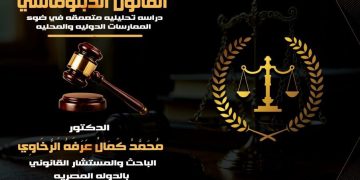Dr A. Hussain Shaban
The following article was published in the May 2022 special issue of the International Review of Contemporary Law, the journal of the IADL, focusing on the 75-76 anniversary of the United Nations Charter.
75 Years after the Establishment of the United Nations
Dr A. Hussain Shaban
The Right to Self Determination and the International Law
The legal emergence of the concept of self-determination is perhaps linked to the rise of the national country concept, especially in its early stages in Europe. Following the outbreak of World War 1 in 1914, and after the first peace conference was held, the idea of self-determination was spread especially among colonized people and ethnic groups who wanted to acquire their independence.[1]
Two Lifters of the Right to Self-Determination
Two fundamental lifters contributed to the rise of the self-determination concept. The first was the socialist left party and its main Marxist movement which was enshrined in the second international conference, held in London in 1986. It was there that a decision was made about the right to self-determination. They announced “… Their support of every nation to have the right and the freedom to self-determination.” They also expressed their sympathy, stating, “Every country who is suffering now from military or national dictatorship or others” and calling “the labourers of all countries to join the class-conscious labourers in the whole world to fight with each other for the decolonization from world capitalism and to achieve the goals of the democrat socialism.[2]”
Vladimir Lenin had clarified what was meant by the idea of a nation’s right to self-determination when he noted “The nation’s right to be independent in the political sense and has the freedom to be politically independent of the dominating and oppressing country.” Lenin also described those who opposed and criticized the ninth paragraph of the Russian democratic socialist labour party program (Bolshevik), which assured the right to self-determination, as political hypocrites and said that they deceived the mass labourers and facilitated the enactment of imperialist policies. He cited three types of countries that applied the right of self-determination.
Furthermore, the Bolsheviks essentially supported the independence of Poland, Finland, Ukraine and Lithuania. Lenin, like all Marxists, believed that nationalism is one of the aspects of capitalism which will vanish with the vanishing of capitalism itself. This is why his first choice was the rise of the nation-state concept, which was a vital step to achieve the construction of a socialist community.[3] It needed a new reading in light of the accumulating historic experience and the reality the new intertwined and intersected phenomenon. Meanwhile, the peace decree committee invited all governments of the fighting countries and their people to immediately begin peace and democratic negotiations. The Soviet governments described it as a kind of peace that was free of colonialism. They considered war as a crime against humanity and they cancelled secret diplomacy and unequal agreements. These included Sykes-Picot regarding Arab countries, which was concluded in 1916 between Great Britain, France, and the Tsardom of Russia.
Moreover, the Bolshevik authority ratified the right to self-determination in the first Soviet constitution in 1918, considered one of the fundamental pillars of the Juridical principles of the new nation.[4] After the October revelation, Lenin applied the principle of self-determination throughout the Empire of Russia, when he issued on November 15, 1917, “The Declaration of Rights of The People of Russia.” It included the right to self-determination and the right to separate and to build an independent country. Despite the deformed application, the October Revolution was very important for the right of peoples to self-determination, especially in the international struggle against colonialism.
The second lifter of the right to self-determination was the declaration of the U.S. president Woodrow Wilson. His 14 principles played a central role in promoting self-determination, especially after the entry of the United States in the war in 1917. Wilson announced that the United States joined the war “to defend freedom,” for the free development of people and against forcing people to live under unwanted sovereignty. As a defender of the right to self-government which developed into the idea of self-determination, Wilson delivered his famous speech to the U.S. Congress on January 8, 1918, which included the aforementioned 14 points. The article of self-determination was included in his 13th point. This was when Wilson advocated the rise of an independent Poland. He underlined this point in his February 1918 speech, pointing out that the right to self-determination is not a mere phrase, but rather an imperative principle of action.[5] Wilson tried to include a special paragraph about the right to self-determination at the time of The League of Nations in 1919, but he did not succeed. From the beginning, the right was opposed by forces that aimed to protect the upraised countries and their interests[6] despite later opposition by the United States. The principles of President Wilson were one of the fundamental lifters on the international level, especially for the people and nations claiming their right to self-determination, particularly the colonized and vassal states.
The right to self-determination is still facing huge obstacles in spite of its universal development, especially in different regions with diverse people. That is because the establishment of the new inhabitant country depends on differing economic, geographic, and strategic factors and considerations. There are also several practical difficulties and restraints hampering the application of this right in different countries and states that use regional unity and sovereignty principles as an excuse.
Between the Two Wars
The right to self-determination remained, between the two wars, closer to an unethical and value-based principle, as a political claim more than a juridical form. But an important incident later paved the way for the acceptance of the right to self-determination and its inclusion in the United Nations Charter, especially after what humanity had suffered from during World War II from 1939-1945.
In addition, the Atlantic Charter, issued by the U.S. President Franklin D. Roosevelt and the British Prime Minister Winston Churchill in 1941, included in one of its sections, “The Principle of Equal Rights and The Right to Self-Determination of People.” However, this right did not acquire legal status until 1945, with the establishment of the United Nations in San Francisco.[7]
The United Nations and the right to self-determination
The ongoing debate caused the International Court of Justice to make “The Right to Self-Determination” a legal imperative in the majority of its decisions. The ICJ gave the right elevated status and it was mentioned twice in the UN Charter. First, it is listed in Article 1, section 2: “The growth of friendly relationships among countries on the basis of equal rights and the right to self-determination.” Second, it was included in the Article 55, which says, “With a view to the creation of conditions of stability and well-being which are necessary for peaceful and friendly relations among nations based on respect for the principle of equal rights and self-determination of peoples, . . . «[8]
The right to self-determination played an important role in the discussions of the United Nations. When it was established in 1945, they discussed the fate of the not self-governed people and districts under the legal restraint system[9].
This right was clarified in the international declaration to liquidate colonialism which assures the right of all peoples to self-determination. It considered any military and repressive actions against dependent people illegal and had to be stopped in order to give these people the chance to enjoy their rights and freedoms in complete independence and peace.[10]
Unfortunately, the Universal Declaration of Human Rights, which the United Nations adopted on December 10, 1945, didn’t include any mention of the right to self-determination, which is considered a major omission. Also, it didn’t include any mention of the rights of minorities.[11] But this was rectified later in four international instruments: Permanent Sovereignty over Natural Resources, General Assembly resolution 1803 (XVII) (December 14, 1962) ; Charter of Economic Rights and Duties of States, General Assembly resolution 3281 (XXIX) (December 12, 1974) ; Declaration on the Rights of Persons Belonging to National or Ethnic, Religious and Linguistic Minorities, General Assembly resolution 47/135 (December 18, 1992) ; and Declaration on the Rights of Indigenous People, General Assembly resolution 61/295 (September 13, 2007).
Nevertheless, the right to self-determination remained an aspiration for people and nations, especially in Asia, Africa and Latin America, where it was codified in two international treaties on December 16, 1966: International Covenant on Economic, Social and Cultural Rights (ICESCR) (entered into force March 23, 1976) and International Covenant on Civil and Political Rights (ICCPR) (entered into force January 3, 1976. Article one of both covenants enshrine the right to self-determination. The ICCPR guarantees minority rights in Article 27.
The first article in both treaties’ states:
- All peoples have the right of self-determination. By virtue of that right they freely determine their political status and freely pursue their economic, social and cultural development.
- All peoples may, for their own ends, freely dispose of their natural wealth and resources without prejudice to any obligations arising out of international economic co-operation, based upon the principle of mutual benefit, and international law. In no case may a people be deprived of its own means of subsistence.
- The States Parties to the present Covenant, including those having responsibility for the administration of Non-Self-Governing and Trust Territories, shall promote the realization of the right of self-determination, and shall respect that right, in conformity with the provisions of the Charter of the United Nations. [12]
It is important to note that the explicit text about self-determination in the two international covenants, which are binding international treaties binding on all states parties. Moreover, they constitute moral, ethical and political principles, as well as legal evidence with respect to all peoples who are demanding this right, even though minorities are not explicitly included in this right. This has led to questioning of the application of the text in Article27 of the ICCPR which is connected to the first article of the covenants that cites the right to self-determination.
Predictions and Interpretations
There may be juridical differences about Article 1 and the extent of its inclusivity, regardless of the preparatory works, which focused on reading and scrutinizing the text as a means to make the article truly inclusive. Specifically, it goes beyond the colonial situation mentioned in the Resolution 1514, which was issued on December 14th, 1960. That is, this right must continue even after the colonial era had ended, especially if the world became free of colonialism and if it benefits the colonies. However, people can continue to benefit from it even after the decline of colonialism.
Some considered that the application of the right to self-determination is restricted to the submissive and colonized people.[13] Others thought that it was a totalitarian right for all peoples when colonialism is abolished. Contrast that position with that of those who didn’t want to expand the right to cover the independent countries or to a part of people or a nation. That is the essence of national and regional unity; that isIndia’s position. On the other hand, Holland talked about the completeness of the text which the UN Human Rights Committee adopted in 1984. However, there are different interpretations of the text depending on political interests and the balance of power, particularly in light of international influence.
The first reading, which considered the text as totalitarian that won’t end when traditional colonialism ends, started from the position that is synchronized with the first article of the two international covenants. They obligate member states with specific commitments, not only towards their own peoples, but also toward peoples who are deprived of the right to self-determination. This reading is more consistent with the Universal Declaration of Human Rights. Perhaps this important conclusion is that the right to self-determination is a deliberate and clear right as far as the second reading is concerned. Some sovereign countries, with ethnic and national diversities, depend on the fear of fragmentation and separation and rely on the regional unity principle and the respect of the political independence, the unity of land, and the sovereignty of nations. They believe that the right to self-determination is an external right of colonized peoples.
As to the internal right, it can be explained as a framework of countries with different forms of self-government. A theoretical and legal explanation for such a problematic issue is due to the differences in meaning between the term “peoples” and “minorities.” The question is whether minorities can benefit from the right to self-determination whether or not a political entity is established. This is what minorities wanted in some countries with national diversities where co-existence is impossible with the absence of a real representation of cultural diversity. Perhaps this is the reason I find this expression more coherent and precise than the minority expression, especially because diversity and pluralism include the equality principle among different and unique, but still equal, components. There is no difference between majority and minority.
The question is whether minorities are considered “peoples” or not, and whether minorities can benefit indirectly from the right that belongs to peoples. This is a very important question that could be affected by new developments in international law. Yet, the concept of “minority rights” has seen a huge development in the last two and a half decades –in international law on the one hand, and the philosophy of politics on the other. This is due to the development of the international norms of the rights of minorities since the achievements following World War II and the end of the Cold War in the late 1980s. The right of minorities moved quickly the internal and international agendas. This was reflected in the adoption of the Declaration on the Rights of Persons Belonging to National or Ethnic, Religious and Linguistic Minorities in 1992 and the Declaration on the Rights of Indigenous Peoples in 2007.
The researcher Will Kymlicka launched in his book “The Philosophy of International Law,” published by Oxford University, several terminologies on the rights of minorities such as multiculturalism, differentiated citizenship, the politics of recognition, group rights, liberal culturalism, and pluralistic integration. However, he prefers liberal multiculturalism terminologies.[14]
Colonialism and the Right to Self-determination: Ambiguity of the Minority Concept
It appears that the right to self-determination listed in the UN Charter belongs to peoples. This issue sparked discussion at the San Francisco Convention where the Charter was adopted. Many phrases were used, such as “state,” “nation,” and “peoples,” which sometimes creates confusion in the juridical meaning or its practical application. This confusion makes it important to follow the historical development and legal context of the right to self-determination. Resolution 1514, the Declaration on the Granting of Independence to Colonial Countries and Peoples, was adopted on December 14, 1960. Its adoption was a positive development that the people of Asia and Africa sought, especially where it declared that “all peoples have the right to self-determination.” (This was reflected in 1966 in the two international covenants. The 1960 declaration also assured the right of peoples to determine freely their political systems and to freely achieve their economic, social, and cultural development.[15]
Decolonization
The historical background of this 1960 declaration is not clear. In addition to its political and legal importance, it became a fundamental starting point for many subsequent international resolutions and declarations. The following day, on December 15, 1960, the General Assembly adopted Resolution 1541, titled « Principles which should guide members in determining whether or not an obligation exists to transmit the information called for under Article 73e of the Charter. » The people in the member states didn’t have the opportunity for self-government (the principle that says the benefits of the people of this district comes first) and they accepted the obligation to commit to working to the best of their ability on the development of their people and international peace and security as required by the Charter. Five of these principles discussed the development of self government without referring to the right to self-determination. But the resolution deliberately condemned colonialism and listed 12 principles that define the colonized districts and their growth towards self-governance to achieve independence.
The difference between Resolutions 1514 and 1541 is that 1514 considers the declaration of independence as the only path to achieve self-determination for not self-governed districts. Resolution 1541, on the other hand, presents a choice either to unite freely or to join an independent country. That is because it considered independence as a natural result for non-self-governed or dependent districts, which is also linked to the right to self-determination and independence.[16]
Despite the respect for the right to self-determination and granting independence in Resolutions 1514 and 1541, minorities were excluded from these resolutions. The right is applied only to “peoples,” not minorities, who are not considered “peoples”’ Whereas In the resolutions, only the “peoples” have the right to independence and to establish an independent country. This issue was the subject of debate both inside and outside the United Nations for almost 10 years, until Resolution 2625 was adopted on November 24, 1970. Titled, “The Declaration of The International Law Principle in Relation to Friendship and Cooperation Relationship Between Countries in Accordance with The United Nations Charter,” it is also known as the declaration of peaceful coexistence, which include seven fundamental principles that formed the essence of the principle in international law.[17]
This resolution mentions the right to self-determination in three sections and emphasizes the unity of the land of the country. But section 7, which is related to the right to self-determination, connects the right to independence with a representative form of government and stresses the unity of the districts by emphasizing the right to self-determination. That is, if the government is not representative, the disconnection is justified. This means that district unity can provide an excuse to stop separation from the government is not representative. In addition, the United Nations Security Council has made many decisions which confirm the right of peoples to self-determination and decolonization. Namibia was the last colony liberated in Africa in 1990,[18] before the colonial settlements in racist South Africa were abolished in 1993. The one international exception is the settler colonial project in Palestine. Sixteen districts didn’t acquire independence and the right to self-determination on the international level.
Distinguishing Two Concepts of Self-Determination
One can distinguish between two concepts of the right to self-determination:
First: based on a district. That means the right of “peoples” in a “country” with all its diverse components to self-government without any external intervention on a political and constitutional basis, particularly for the colonized people. This is enshrined in two international treaties. There is no definition of “peoples”’ except for the permanent residency in a country despite the ethnic and cultural diversity. This is what is called the right to self-determination in a district.
Second: based on identity. That means that the concept of “peoples” is “human society,” which refers to distinguishing ethnic and cultural characteristics. Thus, the right to self-determination of peoples is dependent on their ethnic and cultural identity, which is called the right to self-determination in relation to identity.[19]
It appears that the concept of the right to self-determination exceeded the issue of decolonization and the independence of submissive and colonized states. It reflected the internal part of the self-determination right, in which all “peoples” are aspiring for to rights and freedom and its relationship with the authority. This part has been expanding and has gained support from the international community since the Cold War has ended in the late 1980s. The role of the Security Council has increased to monitor elections and compile statistics about peoples exercising their right to self-determination with cultural diversity. Examples include the elections in South Africa; the national reconciliation in Angola in 1994; the referendum about the issue of the Western desert; the elections and the peace agreement, respecting the will of the Mozambique people’s; and “the military intervention” in Haiti to restore the elected government and the legitimacy.
The International Court of Justice has issued several opinions, including one regarding the Portuguese-Indian conflict in 1954 (the right of passage through India to reach two Portuguese colonies). Although the ICJ has discussed the right to self-determination, it hasn’t applied, but instead, has used the sovereignty principle in international law.
A second case concerned the issue of Cameron against England in 1961. And in 1971, the case of Namibia (Southwest Africa) was considered, which was submitted to the international restraint system in light of the fact that the right to self-determination is applied in self-govern districts.[20] Moreover, Security Council Resolution 688 was adopted on April 5, 1991, regarding the obligation to respect human rights in Iraq and to cease the oppression of the Kurdish region. The role of the Council is toto protect international peace and security and to authorize intervention when oppressed peoples and states cannot achieve their fate by themselves, despite the duality of standards which the Council had followed and the selectivity which had stamped its application.
On the other hand, the decrease in respect for sovereignty and non-interference in the internal affairs of other states raised a juridical legal and political debate. This included the intellectual and philosophical angle entailed by the right to self-determination to which all peoples are entitled. The right applies especially to the colonized or satellite state, those who are oppressed, and peoples whose government doesn’t represent its multicultural diversities. [21]
Likewise, the advisory opinion of the International Court of Justice regarding Kosovo on July 24, 2010, stated that independence (one side separation) does not violate international law. But after the referendum in Sudan on January 9, 2011, that principle was not included. Perhaps the Sudanese referendum, in addition to the Lahai Court decision, will become a legal and judicial precedent that could be relied on internationally to declare independence since unity is considered to be imposed without the consent of a part of the inhabitant, people, or any cultural component.
Not only had Kosovo declared its independence in 2008 and was recognized by the international community despite the opposition of Serbia and Russia for national, religious, and geopolitical reasons, but also East Timor was established by a resolution from the Security Council. This matter requires serious attention as we note the 75th anniversary of the United Nations and the 60th anniversary of issuing Resolution 1514. It has very important intellectual, political, and legal implications and statesments on multinational countries. If they do not reach mutual agreement or understanding regarding the interests of diverse cultural groups, the right to self-determination will be considered from an ethnic identity basis point of view. Either they will remain freely united freely and honor the principle of sovereign equality, or will have the right to form a politically independent entity (state) if coexistence is impossible. This will occur if there is a threat of civil war, for example. These issues are raised on the international level regarding Catalonia in Spain, Belgium between Flanders and Wallonia, and Canada with respect to Quebec and Ireland in England, in addition to many other third world countries as well as our Arab countries. This matter may raise several problems and reactions from the international community, not to mention the established countries which no one has the desire to split or divide. At the same time, it will encourage other multicultural diversities to establish their own independent entities because they want to express their own liberal and free identity after liberation from oppression and domination. This may lead to armed conflicts in which international and regional interests may interfere. It may also result in the resort to illegal solutions, especially if one of the fighting parties feels that the international judiciary or the ICJ is taking their side, whether it is a government or peoples who want to express their secondary identity.
[1]Shaya Riad Shafik- The Rights of Minorities in the Light of the International Law, Dar Al Nahar, 1stflr, Beirut, June 2010, p. 295 and onwards.
[2] International Socialism was established on July 14th, 1889, six years after the death of Marx in Paris, after the unity of the socialist movement in European countries and the United States of America. The second international convention had joined over 20 countries, whereas the first one was established on September 28, 1864, and continued till 1876. Lenin, F.I- The Chosen, 10volumes, 6th volume, Dar Al Takadom, Moscow, 1975-1979, p. 51-55. Look also, Shaban, Abdul Hussain- New Issues in the Arab-Israeli Conflict, Dar Al Kotbi, Beirut, 1987, p. 62-63.
[3]Shaya, Riad Shafik- The Right of Minorities in the Light of International Law, Dar Al Nahar, 1stflr, Beirut, June 2010, p. 257 & 296.
[4] A group of Soviet writers under the supervision: Bonamariov, Gromicko, Khofostov- The History of the External Politics of the USSR, 1st section, 1917-1945, Moscow, 1975, p.30 & onwards.
Tonkin, section A- The Ideological Conflict and the International Law, translated from Russian by Srinska Milna, Prague, 1968, p. 70-71 (in Czech language).
[5] H.W.V Temperley – History of the peace conference of Paris, Vol. 1, London, Oxford University Press, 1920. Pp. 160-161.
[6] Al Masri, Shafik- The right to self-determination in its legal development, The American University Researchers in Beirut, 1997, p.39.
Mr Hussein, Adnan- The right to self-determination, The Armenian issue as an example, The Armenian Center of Studies, 1998, p. 21-46.
[7] Compare: Al Masri, Shafik, The right to self-determination in its legal development, previous source, p.40.
Shaya, Riad, The right of minorities in the international law, previous source, p.299.
[8]Shaban, Abdul Hussain- New Issues in the Arab-Israeli Conflict, previous source, p.61-62.
The United Nations Charter text and the fundamental system of the international court of justice, New York, United Nations, (March 1995).
[9]Shokry, Mohammad Aziz, Dr, The Introduction to International Law According to Peace, Dar al Fikr, 4TH, Damascus, 1980, p.183.
[10]Shaban, Abdul Hussain- New Issues in the Arab-Israeli Conflict, previous source, p.62-63.
[11]Shaban, Abdul Hussain – The human is the origin- introduction to the international law and human rights, Cairo Center, 2002.
Shaban, Abdul Hussain – Masters’ students’ lectures, Salah Aldine University, Erbil, 1999-2000.
The Charter of the United Nations and the fundamental regime of the international court of justice, previous source.
[12] The text of the two international treaties in Al Basiony, Mahmoud Sharif, Human rights, Vol. 1, the regional and international documents.
[13]Shaya, Riad, The right of minorities in the international law, previous source, p.306
[14] Shaya, Riad, The right of minorities in the international law, previous source, p.307.
See also: Bessom, Samantha and Jasioulas, John- The philosophy of International Law, Oxford university press, 2010.
[15] The text of the resolution of the United Nations General Assembly Number 1514, issued on December 14, 1960. www.un.org/generalassemblyresolutions.
[16]Shaya, Riad, The right of minorities in the international law, previous source, p.311.
[17]Shaban, Abdul Hussain – The Ideological conflict in the international affairs, Dar Al Hiwar, Latakia, 1985, p.89 and onwards.
[18] Al Masri, Shafik, previous resource, p.45.
[19] Waldron, Jeremy – The philosophy of international law, Ibid, p. 397-400, Kymlicka, will, Ibid, p. 377-378.
[20] Vital discussions that Mr Shaya transferred, Riad Shafik in his valuable book – The right of minorities in the light of international law, previous source, p.295-319.
[21] Shaban Abdul Hassain – Sovereignty and the principle of human intervention, Lecture at Salah Aldine University, Erbil, 2000 (issued in a copybook later by the university).
* نشرت في IDAL ( (VOL. 3 التي يصدرها اتحاد الحقوقيين الديمقراطيين العالمي في أيار/ مايو 2022 في العدد الخاص بمناسبة الذكرى 75 – 76 لتأسيس الأمم المتحدة في 1 حزيران 2022.

























